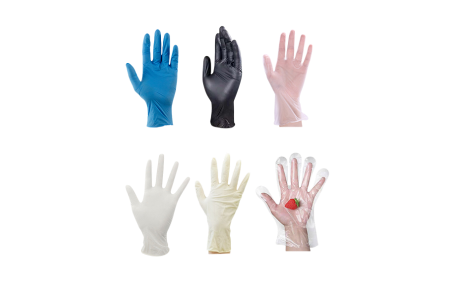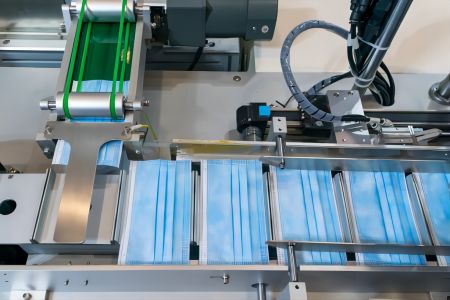2023/6/16

What are the Different Types of Gloves Used in Health Care?
There are many different types of gloves available for healthcare professionals. Different gloves are useful in different situations, and knowing the specific situations where a particular type of glove would be most beneficial can help you choose the right glove for your needs. The most common types of gloves used in health care include Latex examination gloves, disposable latex examination gloves or disposable vinyl examination gloves for sterilization, handling biologicals, and other special circumstances. Used with caution because they may cause allergic reactions in some people. Latex examination gloves are not recommended as the only type of glove used to protect sensitive skin from bacteria and viruses; they should only be used when other options are not an option. Some examples of these situations include when there is no suitable alternative to latex (e.g., a patient with a latex allergy), or if it is unavoidable to use latex because it is the safest option available (e.g., administering vaccines). Powder-free examination gloves for very clean procedures that require sterilization, or disposable vinyl examination gloves that cannot be washed and reused between patients due to potential cross-contamination of infectious materials from one patient’s skin to another’s hands. However, neither powder-free nor disposable vinyl exam gloves have all the protective benefits that more traditional exam gloves offer including moisture-wicking properties, greater comfort, longer durability, and reduced odor compared to less expensive exam gloves. The following article provides further details on possible advantages and disadvantages of different types of exams gloves for high risk.
How do You Choose the Right Glove for Your Procedure?
Choosing the right glove is just as important as choosing the right gloves for the right situations. If you use the wrong glove for a particular situation, it may negatively impact your procedure and the safety of your patients. There are many factors to consider when choosing the right glove for a particular procedure. If you are choosing a glove to wear in your diagnostic procedures, the most important thing to consider is the safety of the patient. If you wear an unsafe glove in a procedure where one of your fingers is already cut or damaged, you could be exposing your patient to possible infection or other bodily harm. If you are choosing a glove that you will wear on your patients, some of the most important factors to consider include the following:
- Is the glove suitable for the specific procedure you are performing? For example, if you are using your glove for a procedure that requires the use of many delicate instruments that may be damaged by a glove that is not suitable for that procedure, the glove may negatively impact your patient’s care. - Is the glove suitable for the patient’s individual needs and preferences? For example, if a patient has skin with a high oil content that is particularly difficult to clean, they may experience increased discomfort wearing a glove that is not suitable for their individual needs.
- Is the glove suitable for the patient’s skin type? For example, some people have a particular allergic reaction to certain materials even when they do not experience an allergic reaction to other materials. A glove that is suitable for one person may not be suitable for another person with the same skin type.
Latex Examination Gloves
Latex examination gloves are durable, barrier-forming gloves that can be worn for a variety of different procedures. They are available in many different styles and types of material to choose from to best fit the needs of a particular patient, procedure, or healthcare setting. There are a few different qualities of latex examination gloves that are important to consider when choosing the right glove for your situation. - Durability: Exam gloves should be durable enough to last throughout the procedure but not so durable that they become uncomfortable or difficult to use. - Grip: Some gloves have a tacky texture that makes them easier to hold onto, while others have a smooth texture that makes them more difficult to grip. After a procedure, some people may experience a sensation of “slippage” when they try to pick up a paper or other item if the glove has a smooth texture, while others may experience a sensation of “stickiness” when the glove has a tacky texture. - Moisture Absorption: Certain gloves are designed to have greater moisture absorption properties, while others are designed to have greater resistance to moisture absorption.
Disposable Vinyl Examination Gloves
Disposable vinyl examination gloves are a type of examination glove that is designed for one-time use and cannot be washed or reused. These gloves are designed for situations where there is a high risk of cross-contamination between one patient’s hands and another patient’s hands, or if the glove you are wearing is soiled and cannot be cleaned. Disposable vinyl gloves are most commonly used in the sterile processing of biological specimens such as blood samples, swabs, sputum specimens, and urine samples. They are also used in situations where there is a high risk of cross-contamination between one patient’s hands and another person’s hands. Disposable vinyl gloves are generally not recommended as the only type of glove used to protect sensitive skin from bacteria and viruses; they should only be used when other options are not an option.
Powder-free Examination Gloves
Powder-free examination gloves are a type of examination glove that is designed for very clean procedures that require sterilization, or disposable vinyl examination gloves that cannot be washed and reused between patients due to potential cross-contamination of infectious materials from one patient’s hands to another’s hands. There are a few different qualities of powder-free gloves that are important to consider when choosing the right glove for your situation.
- Durability: Most powder-free gloves are not designed to be durable enough to last throughout a procedure, so durability is not as important as it is for more traditional gloves.
- Grip: Powder-free gloves generally have a tacky texture that makes them easier to hold onto. After a procedure when some people may experience a sensation of “slippage” when they try to pick up a paper or other item if the glove has a smooth texture while others may experience a sensation of “stickiness” when the glove has a tacky texture.
- Moisture Absorption: Most powder-free gloves are designed to have a high resistance to moisture absorption.
Other Types of Gloves Used in Healthcare
There are many other types of gloves designed for different applications, and some of the other types of gloves used in healthcare include:
- Sterile gloves: These gloves are designed to be worn for clean procedures, such as suctioning or inserting intravenous needles. Some also have a special cover on the fingertips to cover this area and protect it from getting contaminated.
- Disposable plastic gloves: These gloves are designed to be worn for clean procedures such as handling foods or cleaning with water, but they cannot be washed and reused like disposable vinyl gloves.
- Latex exam gloves, disposable vinyl exam gloves, or powder-free exam gloves: These are a combination of the types of gloves discussed above and are designed to best fit the needs of a particular patient, procedure, or healthcare setting.
Gloves Made from Other Materials
Some gloves are made of materials other than latex or vinyl, including:
- Nitrile examination gloves: These gloves are made of a synthetic material that is non-allergenic and has properties similar to latex. They are generally recommended for use with sensitive skin, as they are more resistant to moisture absorption than latex and vinyl gloves.
- Neoprene examination gloves: These gloves are made from a synthetic material that is non-allergenic and resistant to moisture absorption, making them a good choice for very clean or sterile procedures. They are also available in a variety of different styles and colors to best fit the needs of a particular patient.
Conclusion
Exam gloves are an important piece of equipment in the health care field. They can protect your hands from damage in many dangerous situations, such as when a patient has an open wound or is bleeding. Different types of gloves can be used depending on the situation. Latex examination gloves are used when there is no other option, such as when a patient has a latex allergy. Disposable vinyl exam gloves are a good option when you need to use gloves that cannot be washed or reused, such as for sterile procedures or when you have a high risk of cross-contamination of infectious materials. Other types of gloves are available, such as powder-free examination gloves and gloves made from other materials such as neoprene. You should always be prepared when working with your hands, and a box of gloves can help you be prepared for any situation.




 WhatsApp
WhatsApp
Send us your message
You can send an email asking for the price and detailed information of this product. We will reply you as soon as we receive your email